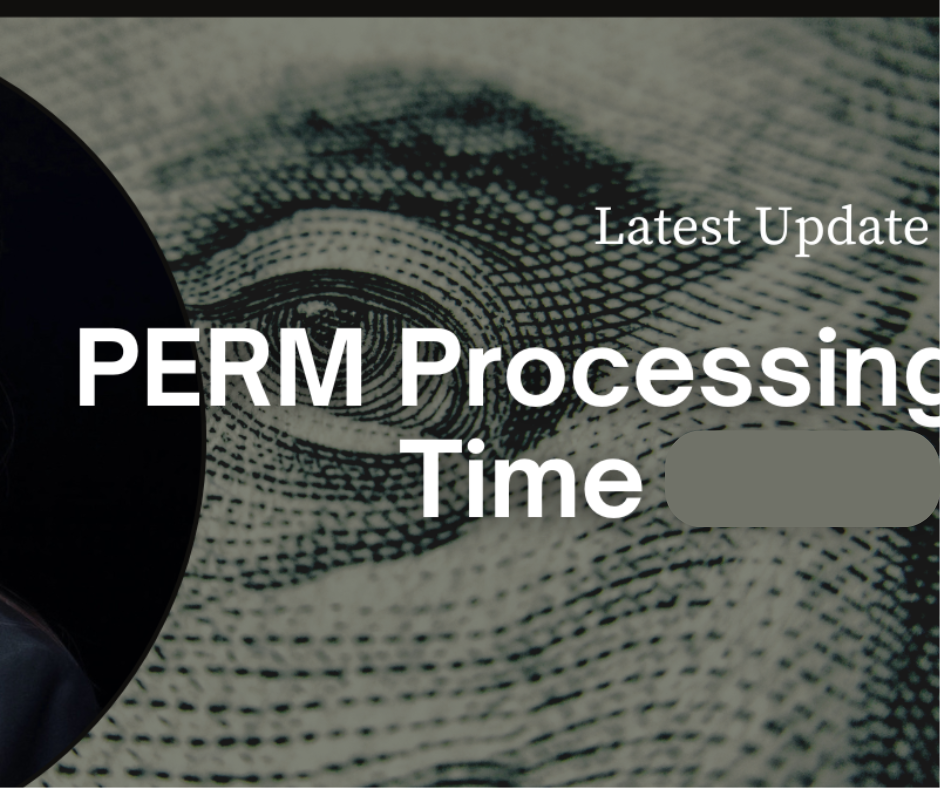Latest Update: PERM Processing Time

Understanding PERM Processing Time: A Comprehensive Guide
Brief Overview:
Foreign workers who hope to get permanent residence or employment-based immigration beginning in 2023 frequently worry about the length of the PERM application procedure. The Department of Labor (DOL) is in charge of the Program Electronic Review Management (PERM) procedure, which verifies foreign workers for different employment-based visas. This blog article will go over the present schedule, potential influences on the 2023 PERM processing period, and ways that candidates may keep informed about any updates.
Importance of PERM Processing Time:
The time it takes to complete a PERM is crucial for both companies and international employees. Work permits for foreign workers may expire, employment plans may be disrupted, and uncertainty may be prolonged by delays in the processing timeframe. Thus, for a successful and seamless immigration procedure, it is important to comprehend and manage the PERM processing time.
For enterprises and international employees, it is crucial to comprehend and manage the PERM processing time. Delays may make things difficult for both parties. Businesses might find that it disrupts their planning and increases expenses. They could even lose competent employees. For foreign laborers, the uncertainty of being able to continue working may be extremely stressful. A major issue for the company might arise if their visas expire due to delays, particularly if they require specialized expertise. Therefore, it is imperative that everyone monitor the PERM processing time to ensure that everything proceeds as planned.
Stages of PERM Processing:
Perm processing times follow the different step to perform the several tasks every task its own specification and deadline. The main purpose of these stages to create jobs, prevail age determination, test workers market and generate results, all these processes apply in perm processing time.
PERM Processing time Step 1:First Job Creation
In this stage perform various tasks such that define job title, Requirements of qualification for job, Need of experience for this job. And how many people manage in previous job. When all requirements is fulfill then filing out the form
That time employee does not work properly and not perform our task properly then perm processing reject that employee. Checking the employee performance total time is 1month.
PERM Processing Time Step 2: Prevailing Wage Determination
The PWD is the very least that an employer must give a foreign worker who fills a position. This wage rate needs to be fair in order to protect the rights of international workers and the integrity of our country’s labor market. The typical PWD processing time for non-union employment is 6–8 months, whereas it is 10 months for union work. The time needed to get the PWD must be taken into consideration by companies as they plan their hiring and marketing efforts for the PERM processing times.
Perm processing time: 6 to 10 months.
PERM Step 3: Worker Market Test and Conduct Result
To prevent any eligible American workers from applying for the employment, employers must conduct a labor market test as part of the PERM process. Companies have to follow certain guidelines when it comes to hiring, such filing ads with the state labor department for a full thirty days. making announcements for ten days in a row at work and publishing twice a week on Sundays in the neighborhood newspaper. Companies should schedule PERM applications taking into account the time needed to finish the recruiting process. In addition, they want to collaborate closely with their legal counsel to guarantee compliance with all recruiting regulations. Throughout this procedure, maintain an accurate record of the recruiting reports.
Factors Influencing Processing Time:
Several factors affect how long the PERM procedure takes. The volume of applications received by the Department of Labor is one factor to consider. It can take longer to process them if they get a lot. Furthermore, modifications to the regulations may also cause delays. Another factor that may contribute to delays is the Department of Labor’s occasional staffing shortage. Furthermore, certain situations require more time to examine since they are more complex than others. People may make better plans and comprehend why things take time by being aware of these factors.
Average Processing Time for Each Stage:
The processing time for each stage of the PERM process can vary widely. Most of the Job creating sites take one to two months and the privilege perm processing time take four to five months and filling the PERM application via EAT form 9089.
Navigating Delays and Audits:
In the PERM process, delays and audits are frequent despite meticulous preparation. Backlogs, inconsistent documentation, or haphazard audits started by the DOL can all cause delays. In the case of an audit, employers are required to react quickly and supply the necessary data in order to prevent additional delays in the processing schedule.
Checking PERM Status and Seeking Assistance:
Both employers and applicants can use the Permanent Case Management System or the Department of Labor’s website to track the progress of their applications online during the PERM process. Should there be significant delays or issues, consulting with a knowledgeable immigration lawyer can be very helpful in guiding you through the PERM procedure.
Individuals can monitor the progress of their applications online during the PERM process. They can use the Permanent Case Management System or the Department of Labor’s website to do this. This enables them to monitor the performance of their application and detect any changes.
Conclusion:
It is essential for foreign workers and employers to comprehend and manage the PERM processing timetable. Plans may not go as planned, and delays may cause concern. It is therefore essential that everyone understands the possible duration and is ready for any delays. Employers are required to make sure that all documentation is filed on time and to closely adhere to the rules and deadlines related to each stage of the PERM procedure. The volume of applications, changes to the rules, and the workload of the Department of Labor can all make the process take longer. To keep things running smoothly, employers must collaborate with the Department of Labor and respond quickly to audits and delays.
Click Here for more information.











![Russia President Putin starts new term with challenge [West]](https://newsmaximize.com/wp-content/uploads/2024/05/1-3.webp)
